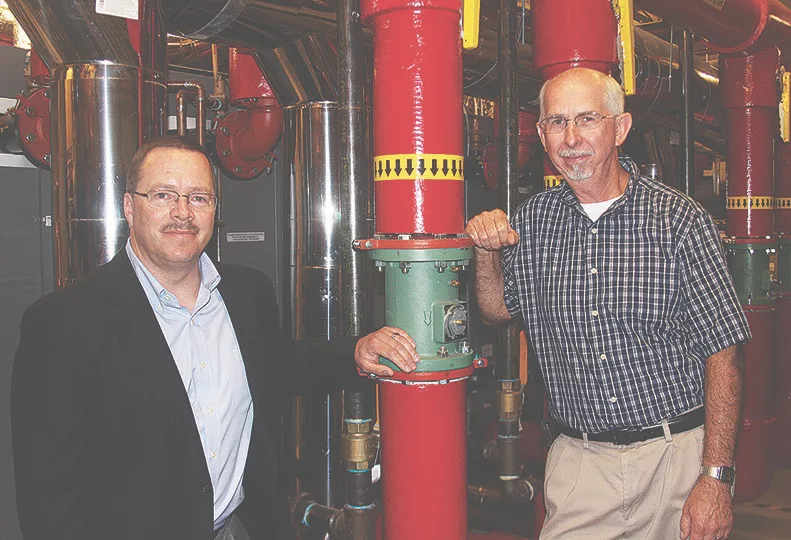Kiemle & Hagood subsidiary promotes greener building management practices
brokerage's subsidiary works to help owners find savings

Kiemle & Hagood Co. says it and a facility-services subsidiary it operates have been using greener building management and maintenance practices they implemented fully three years ago to help building owners and tenants achieve sizable energy savings.
The Spokane-based commercial real estate and property management company estimates that the efficiency-focused practices so far have saved more than $4.8 million in energy costs at clients’ properties that it manages.
Gordon Hester, Kiemle & Hagood’s vice president, says the environmentally focused emphasis probably reduced the total amount of energy used in the buildings the company manages by around 15 percent last year, though final numbers aren’t available yet. He adds that the company is aiming for an additional 10 percent reduction this year.
“It’s been great forward progress,” Hester says.
Kiemle & Hagood started launching energy-efficiency projects at buildings it manages back in 2000, he says, but “really ramped them up” in January 2011 when it began adopting strategic energy management practices promoted by the Northwest Energy Efficiency Alliance.
That Portland-based nonprofit organization and its partners seek to increase market understanding of energy-efficiency practices and benefits through competitions, one-on-one business coaching, and targeted education and training. The alliance includes more than 100 Northwest utilities and energy-efficiency organizations working on behalf of more than 12 million energy consumers, according to its website. Hester says Kiemle & Hagood was introduced to the alliance by Spokane-based energy company Avista Corp.
Jerry Van Guilder, director of the subsidiary, K&H Facility Services LLC, says, Avista “has been a great partner” in the whole process.
The practices Kiemle & Hagood has adopted include performing boiler tune-ups, operational training, and scheduled efficiency monitoring, as well as transitioning buildings to more energy-efficient lighting.
The practices also include things such as revising janitorial routines to maximize energy savings and having technicians do “night walks” to verify that thermostat setbacks, after-hour fans, lighting controls, and other systems are operating properly or shut down.
Achieving the efficiencies sometimes can require costly upgrades to the buildings, and Hester says, “You have to do the analysis, and show the payback and return on investment” to convince building owners that the expenditures make sense.
“Every owner has their threshold for return on investment, but financing has gotten better for some of this stuff over the last two years,” he says, adding, “I would say most owners have been pretty receptive.”
Kiemle & Hagood manages a total of about 4.5 million square feet of commercial space in about 120 buildings, mostly in the Spokane area but also including properties as scattered as Sandpoint and Walla Walla.
The Northwest Energy Efficiency Alliance encourages implementing energy-saving contests among property managers and facility technicians for various buildings, and Hester and Van Guilder say that friendly competition has had a motivating and morale-boosting effect on employees.
Winners of Kiemle & Hagood’s Kilowatt Hour Reduction Contest are recognized semi-annually, with the property manager and facility technician of the top-ranking building for that six-month period each receiving a $250 reward. The company also runs a newspaper advertisement highlighting their accomplishments.
The ranking is based on the percentage of improvement in a building’s Energy Use Index score, which the U.S. Environmental Protection Agency’s Energy Star program calculates for participating properties.
“We’ve really tried to take the approach to celebrate when you find something you can do better,” Hester says. “The nice thing is it’s been really fun to recognize the technicians. They have really embraced it. It has created a great willingness to share information.”
Examples of properties where the efficiency-focused practices have produced significant benefits include the 15-story building at 601 W. Main where Kiemle & Hagood’s offices are located; the 16-story Washington Trust Financial Center, at 717 W. Sprague; and the landmark Flour Mill retail and office center, at 621 W. Mallon.
Improvements completed at the 40-year-old building on Main over several years have translated into more than $800,000 in accumulated savings, Kiemle & Hagood says. Meanwhile, a wide range of upgrades at the 119-year-old Flour mill reduced natural gas costs and electricity use there by 50 percent and 10 percent, respectively, it adds.
K&H Facility Services, founded in 2007, employs 32 technicians who hold special training and handle a range of maintenance tasks, from electrical and mechanical system monitoring and repairs to locksmithing. Kiemle & Hagood, among its roughly 70 other employees, has nine building managers who work closely with the technicians.
Van Guilder, who joined Kiemle & Hagood in 1982 and is an accredited facilities management administrator, manages the subsidiary and oversees the technicians’ training, regulatory compliance, and safety issues.
“The thing I see in him is he has always been very passionate about ensuring that our buildings operate well,” Hester says, adding that Van Guilder’s passion carries over to the technicians and is manifested in the pride they show in the work they do.
Van Guilder says part of the discipline in adopting the efficiency-focused practices championed by the regional energy efficiency alliance involves maintaining regular training and constantly reevaluating how to manage buildings better.
“This opened up our eyes to a lot of things we were overlooking, so it’s been a great tool,” he says, adding, “I think the next step is to take it beyond electricity and gas (consumption) and into all aspects of the building. I think it will continue to help us in all aspects of what we do.”
Related Articles
Related Products

_c.webp?t=1763626051)
_web.webp?t=1764835652)

